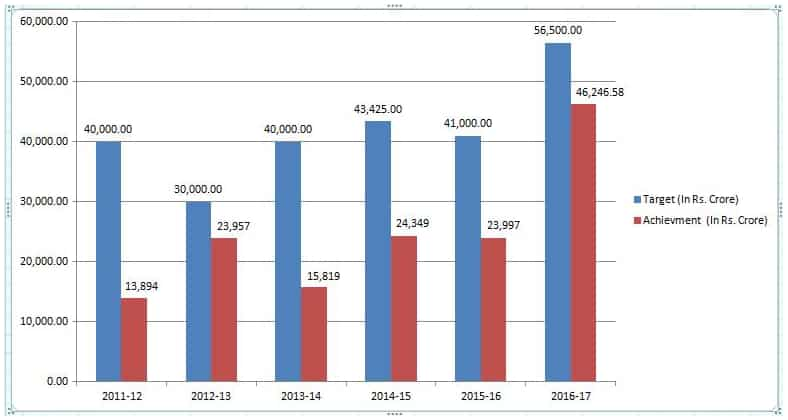Will the govt increase disinvestment targets for FY19?
The BSE on its website explains that the main objective of disinvestment is to indicate that PSUs had shown a very negative rate of return on capital employed.

In the upcoming Union Budget, many would keenly watch the Finance Ministry's statement on disinvestment targets as it is considered to be the key component for fiscal target's final picture.
The disinvestment policy, initiated since July 1991 in India, is referred to as an action of an organisation (government) selling or liquidating an asset or subsidiary. It basically refers to sale from the government, partly or fully, of a government-owned enterprise.
Despite missing its disinvestment targets since past six fiscal, the Finance Ministry raised the target to a whopping Rs 72,500 crore for fiscal 2017-18 during the last budget. Finance Ministry Arun Jaitley had said, “The government plans to raise about Rs 72,500 crore through disinvestment of central public sector enterprises (CPSE) in 2017-18.”
After this announcement in the last budget, Venkataraman Rajaraman, Associate Director at India Ratings, said, “Achieving 3.2% fiscal deficit target also depends on the government’s success in achieving the Rs 72,500 crore of disinvestment receipt in 2017-18, in 2016-17, the government expects Rs 45,500 crore disinvestment receipt as against Rs 56,500 crore budget estimate.”
The BSE on its website explains that the main objective of disinvestment is to indicate that public sector undertakings (PSUs) had shown a very negative rate of return on capital employed.
Data compiled by the BSE mentioned that about 10– 15% of the total gross domestic savings were getting reduced on account of low savings from PSUs. Hence, the need for the government to get rid of these units and to concentrate on core activities was identified.
Let's have a look as to where does Indian government stand in meeting its disinvestment target.
According to data of DIPAM (Department of Investment and Public Asset Management), current fiscal year's disinvestment performance is better compared to previous fiscal. For FY18, total of disinvestment target was divided in three parts – CPSEs disinvestment, strategic disinvestment and listing of insurance companies.

DIPAM's data showcased that as on January 02, 2018, government has achieved Rs 32,321.92 crore from CPSE disinvestment compared to their target of Rs 46,500 crore. While Rs 4,153.65 crore has been achieved from strategic disinvestment so far in FY18 compared to their target of Rs 15,000.
It was only listing of insurance companies that overshoot the disinvestment target of Rs 11,000 crore this fiscal. Government has raised about Rs 17,357.48 crore from this mechanism with listing of The New India Assurance Company Limited and General Insurance Corporation Of India.
Indian government has thus raised about Rs 53,833.05 crore – which would be over 74% of disinvestment target.

The performance of disinvestment has been lackluster between FY12 and FY17.
In previous fiscal (FY17), the government could manage to raise about Rs 46,246.58 crore from its target of Rs 56,500 crore. Underachievement of the target has been the case since last six years.
Analysts are very optimistic on FY18 performance, as they believe government has the potential to fulfil the target.
Sanjeev Prasad, Suvodeep Rakshit, Sunita Baldawa and Anindya Bhowmik of Kotak Institutional Equities earlier said, “Government had many options to raise larger amount from divestment of its stakes in state-owned companies, but has consistently fallen on meeting divestment targets given limited appetite among investors and low clarity on the divestment schedule.”
India Ratings and Research (Ind-Ra) believes the successful subscription of Bharat 22 Exchange Traded Fund, launched in November 2017, has helped the government move closer to its FY18 non-debt capital receipt target of Rs 72,500 crore.
Ind-Ra added that the government could exceed its capital receipt target in the remaining four months of FY18, depending on Oil and Natural Gas Corporation’s acquisition of government stake of 51.11% in Hindustan Petroleum Corporation Limited.
The agency opines the disinvestment strategy has the potential to generate Rs 1 lakh crore and provide buffer against lower surplus transferred by the Reserve Bank of India and the likely shortfall from the telecom sector.
Aditi Nayar, Principal Economist at ICRA, said, “If the proposed acquisition of the GoI’s stake of 51% in Hindustan Petroleum Corporation Limited by Oil and Natural Gas Corporation gets completed in the current fiscal, total disinvestment proceeds would exceed the budgeted level, helping to offset some of the feared shortfall in tax and non-tax revenue.”
06:41 PM IST






 Bids for BPCL, Railways' arm Concor and others: How mega disinvestment plan of Modi government is a big shot in the arm of Indian economy
Bids for BPCL, Railways' arm Concor and others: How mega disinvestment plan of Modi government is a big shot in the arm of Indian economy  Budget 2019: PSB ETFs coming? After, Bharat 22, CPSE Exchange Traded Funds, a new disinvestment pattern can emerge
Budget 2019: PSB ETFs coming? After, Bharat 22, CPSE Exchange Traded Funds, a new disinvestment pattern can emerge Bharat ETF 1-day issue oversubscribed 10 times, government to retain Rs 10k crore
Bharat ETF 1-day issue oversubscribed 10 times, government to retain Rs 10k crore Budget 2019: Rs 800 bn target! Disinvestment in public sector companies - a trump card for govt?
Budget 2019: Rs 800 bn target! Disinvestment in public sector companies - a trump card for govt? Air India salaries not paid in March; national carrier yet to reveal reason to staff
Air India salaries not paid in March; national carrier yet to reveal reason to staff